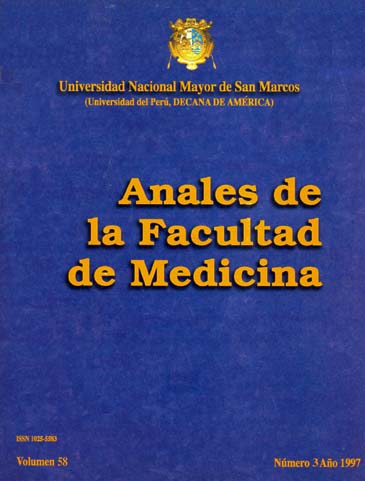Abdominal Laparoscopic Surgery 1991-1995 Experience - Hospital Guillermo Almenara Irigoyen
DOI:
https://doi.org/10.15381/anales.v58i3.4669Keywords:
Surgery, Surgery Operative, PeritoneoscopyAbstract
This article presents the development of abdominal laparoscopic surgery at the Hospital Guillermo Almenara, since their beginnings, on september 1991, to december 31th 1995; and involve a review of 2750 medical records from patients who underwent this surgery. Cholecistectomy account for 96% of the cases, followed in frequency by inguinocrural hernioplasty (0,88%), splenectomy (0,85%) and cholectomy (0,38%). It is important to underline that there had been an increasing number of surgical procedures (in the field of laparoscopic surgery) other than cholecistectomy, which constituted a little proportion up to 1993: 1,3%, increasing to 2,6% at the ending of 1994, and to 4% at the end of this study. There had been a total of 2465 cases of laparoscopic cholecistectomy, showing a predominance of female patients and a mean age of 44 for females and 51 for males. Convertion index was 4,9%. Total morbility rate was 9,36%; 7% of patients had mild complicationsand there were only 2,36%of patients who needed a second surgery. Mortality rate was 0,24%, and was due to lesions of the biliary tract. We must underline the important advances obtained at our hospital with respect to splenectomy, which had been modified from their original form by our staff of surgeons, accomplishing a convertion index of 4,76%, which is better than the values obtained at another countries. Colonic surgery, composed by ten cases, all of them on the left side, deserves special attention. Nine of the cases were sigmoidectomies, and one was a resection of transverse colon; volvulus was the most frecuent indication for surgery; there were three cases of adenocarcinomas, one villous adenoma and one diverticulum. This study constitutes a testimony of the maturity accomplished by our surgeons on the field of laparoscopic surgery, which let an adequate solution for vesicular pathology and begin to do a satisfactory management for hernias and splenic and colonic pathology.Downloads
Published
1997-09-15
Issue
Section
Trabajos originales
License
Copyright (c) 1997 Alejandro Bazán Gonzáles, José De Vinatea, Luis Villanueva, Hugo Fuentes, Luis Poggi, Luis Saldarriaga, Jorge Ayras, Herber Cóndor, Genaro Montero

This work is licensed under a Creative Commons Attribution-NonCommercial-ShareAlike 4.0 International License.
Those authors who have publications with this magazine accept the following terms:
- Authors will retain their copyrights and guarantee the journal the right of first publication of their work, which will be simultaneously subject to Creative Commons Attribution License that allows third parties to share the work as long as its author and its first publication this magazine are indicated.
- Authors may adopt other non-exclusive licensing agreements for the distribution of the version of the published work (eg, deposit it in an institutional electronic file or publish it in a monographic volume) provided that the initial publication in this magazine is indicated.
- Authors are allowed and recommended to disseminate their work over the Internet (eg: in institutional telematic archives or on their website) before and during the submission process, which It can produce interesting exchanges and increase quotes from the published work. (See El efecto del acceso abierto ).
How to Cite
1.
Bazán Gonzáles A, De Vinatea J, Villanueva L, Fuentes H, Poggi L, Saldarriaga L, et al. Abdominal Laparoscopic Surgery 1991-1995 Experience - Hospital Guillermo Almenara Irigoyen. An Fac med [Internet]. 1997 Sep. 15 [cited 2024 Jul. 5];58(3):165-7. Available from: https://revistasinvestigacion.unmsm.edu.pe/index.php/anales/article/view/4669















